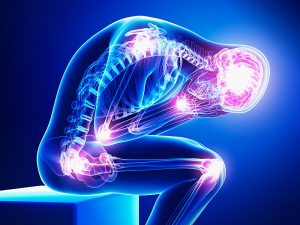Despite being a universal human experience, pain can vary greatly in intensity, quality, and duration from person to person. The exact same stubbed-toe might be described as aching, burning, or stabbing, depending on the toe’s owner. The pain from it could linger a few hours or a few days, and it may be constant or come in waves.
Over 50 million Americans are estimated to have chronic pain or severe pain in a given year, and its drain on the healthcare economy is immense.
As far as your body and brain are concerned, pain is information. Pain messages from your body are sent to your brain to let it know the consequences of interaction with the outside world. The brain uses this information to adjust some or all of a body part’s motion.
If you put your palm on a hot stove, the pain message makes your brain quickly withdraw the hand from the heat source. The pain that lingers afterwards forces your brain to take pressure off the healing tissue; you won’t be pushing up from a chair with your burned hand for a few days. In this sense, pain is a necessary, temporary evil that prevents further damage to the body.
Pain is deeply tied to emotion. It can make us feel sad or angry, helpless or depressed. Everyday aches and pains tend to be worse when we are stressed, tired, or upset. Conversely, being in pain can lead us to become more easily stressed, tired, or ill. When it comes to treating pain, distinguishing between acute and chronic pain is crucial, so let’s explore their differences.
“Pain is an opportunity to learn about yourself”
Acute pain is the type that we, as a society, usually generalize to all types of pain. After a body tissue is damaged or irritated, the tissue sends a message to the brain saying ‘you need to leave me alone for a while so I can fix the damage’.
It sometimes helps to think of our pain system as a car alarm, and that all alarms have different sensitivities. If I have two different cars in the parking lot, one’s alarm may blare with a little jostle while the other‘s stay silent until your throw a brick through the window.
This analogy fits with chronic vs. acute pain as well. Acute pain is the alarm not going off until the window is smashed. The alarm in people with chronic pain is set off much more easily, meaning irritants that would not hurt a pain-free person may be very painful for someone with chronic pain.
“Pain is inevitable. Suffering is optional.”
It’s unfortunate that chronic pain shares its nomenclature with acute pain because they are very different phenomenon. While there is nearly always tissue injury or irritation in acute pain, this is less often the case in chronic pain. Chronic pain is pain which persists beyond expected healing times of an irritated tissue. Around 6 months is when the definition of pain changes from acute to chronic. One of the main frustrations with chronic pain is that it is hard to get over the notion that because something hurts, there is not necessarily something broken, damaged, or torn.
Chronic pain is frustrating to deal with because it is a self-driving, vicious cycle. Pain interferes with sleep, appetite, desire to be physically active, and willingness to participate in social activities. As you can imagine, eating poorly, not sleeping, sitting on the couch too much, and dropping out of social events, all increase feelings of stress and depression, which in turn increase pain.
Your body has a finite number of resources. Let’s say that on a given day, 80% of the resources are devoted to keeping your body running normally, and that 20% are keeping your pain under control. If you are fighting a cold, arguing with a loved one, or sleep-deprived, more resources need to be added to that 80%. So now you only have 10% of your resources available to control the pain, and as a result, it increases considerably. When I am treating a patient for any kind of pain and they have a spike in pain without any new injury or strain, increased stress at home or work or a pending cancellation from a flu-bug are on my radar.
The take-home recommendation I have for pain sufferers is this:
- Acute pain-If you have an acute injury that lasts longer than 2-3 weeks or is very severe, talk to your physical therapist or doctor. Early intervention can help prevent acute pain from becoming chronic.
- Chronic-If you suffer from chronic pain, speak to your doctor and see a physical therapist about developing a movement and exercise program that is within your tolerance. You should also make sure that you are sleeping reasonably well and eating a balanced diet.
I’ll leave you with one of my favorite sayings when it comes to pain: “Motion is lotion, and if you quit moving, you will quit moving”.








